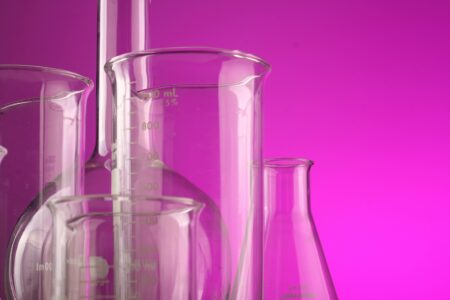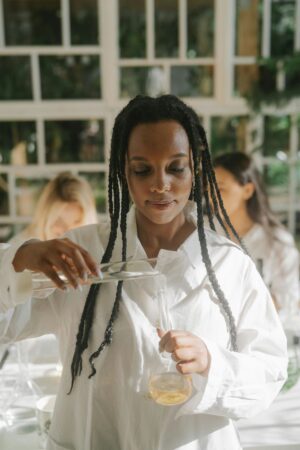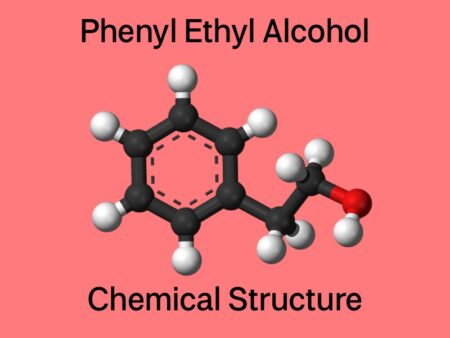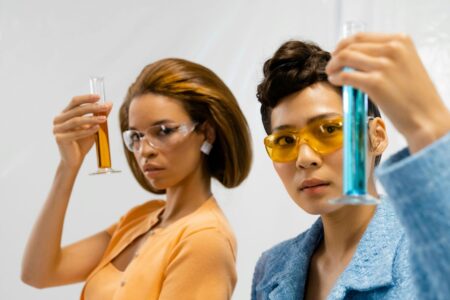
Natural rose materials mouillettes for this article on natural perfumes and chemicals by Gabrielle
As a natural perfumer, I’m used to fielding questions about ingredients. One question, though, still stops me in my tracks: “Does this have any chemicals in it?”
At first, I assumed people meant synthetics. But more than once, I’ve realized they were asking if the perfume contained any chemicals at all. And that presents a great opportunity to clear the air.

Lab glassware Rodolfo Clix, Pexels
Let’s go back to high school chemistry for a moment: everything in the physical world is made of chemicals. Water is a chemical. Vitamin C is a chemical. Rose oil? Also a chemical; just a very complex one made by nature. So, when we talk about “chemical-free” perfumes, what we really mean is “free of synthetic chemicals.” But even the most pristine, organically sourced, artisanal natural perfume is made entirely of chemicals – just ones that were created by a flower, a tree, or a resin-producing shrub rather than a lab technician.

Lab tech with Erlenmeyer flask, Yaroslav Shuraev, Pexels
Here’s the real distinction:
Synthetic fragrance materials are built in a lab, often starting from petrochemical feedstocks. Chemists isolate, combine, and rearrange molecules to mimic the scent of natural substances, or to create entirely new ones.
Botanical fragrance materials in natural perfumes are extracted from botanical sources. The process may involve steam, solvent, or CO₂ extraction, sometimes followed by molecular distillation, but the resulting materials are made up of naturally occurring chemicals produced by the plant itself.
So yes, natural perfumes are chemical, too, just from a different kind of source.

Woman smelling roses, Andrea Piacquadio, Pexels
Let’s ground this in a practical example: the rose.
First, not all roses are chemically identical. Different varietals, such as Rosa damascena, Rosa centifolia (often called Rose de Mai), Rosa gallica, and Rosa alba, each contain their own unique aromatic signatures. These differences in genetic makeup translate into varying concentrations of key fragrance molecules.
And it doesn’t stop there. The chemical profile of a rose also depends on where and how it’s grown. Factors like soil composition, climate, altitude, and even the timing of the harvest influence the final scent of the flower. This is why the same rose varietal grown in Bulgaria, Turkey, Morocco, or France can produce subtly different olfactory results. In perfumery terms, this is where terroir comes into play.
From these diverse roses, we can obtain natural extracts using several methods:
– Steam or hydro-distillation results in rose otto (an essential oil);
– Solvent extraction followed by an alcohol wash yields rose absolute;
– CO₂ extraction produces rose CO₂ extract.

Phenyl Ethyl Alcohol Model, Ben Mills & Jynto, Wikipedia
Each extraction method pulls different compounds in different proportions. For instance, rose otto is made with high heat and contains very little phenyl ethyl alcohol, which is one of the main components of fresh rose scent. This is because it’s too volatile and gets lost during the distillation process. Rose absolute, which avoids high temperatures, retains much more phenyl ethyl alcohol; it often smells deeper and more honeyed. Rose CO₂ extract typically falls somewhere in between.
Regardless of the varietal or extraction process, a single rose contains hundreds of naturally occurring aromatic compounds. Among the most prominent are phenyl ethyl alcohol, geraniol, citronellol, and nerol. But some of the most impactful molecules exist only in trace amounts. Beta-damascenone and other rose ketones, for example, are present in mere fractions of a percent, yet contribute immensely to the richness, depth, and that elusive “rosiness” we associate with the living flower.

Chic science, Cottonbro Studio, Pexels
In mixed-media perfumery, rose is often reconstructed using synthetics. A typical “rose base” or “accord” might include synthetic versions of phenyl ethyl alcohol, geraniol, citronellol, and nerol blended with a handful of other lab-made molecules to recreate the scent of a rose, or more specifically, the headspace around it.
Sometimes, a perfumer will add a touch of natural rose otto or absolute – not for its olfactory contribution, but for label appeal. The final result may smell incredibly rosy and sometimes even more so than the natural extracts themselves.
There’s no such thing as a chemical-free perfume. Every perfume, natural or otherwise, is made of chemicals. The question isn’t whether chemicals are present; it’s whether those chemicals were produced by nature or by a laboratory. Understanding this distinction helps demystify perfumery, especially for those who gravitate toward natural fragrance out of concern for what they’re putting on their bodies. It’s not about fear of chemicals; it’s about choosing the kind of chemistry you prefer.
In the end, perfume is both art and science. And like any good art form, it helps to understand the materials before you judge the work.
Gabrielle Durand, Contributor and perfumer for On The Nose Perfumes
Gabrielle Durand is a CaFleureBon Notes From The Lab Co-Contributor
Read her Profile in American Perfumery here
PLEASE SUPPORT OUR ARTISAN PERFUMERS AND BY DIRECTLY FROM THEIR SITE
All photos are owned by On The Nose Perfumes, unless otherwise stated.

As a thank you for enjoying Gabrielle’s Notes from the Lab, Gabrielle is offering one 15 ml flacon On the Nose Thorny Issue for one registered reader in the continental USA. Please register here or your comment will not count. To be entered, in the comments section below, share what surprised you most about the chemistry of natural perfumes. Draw closes 5/18/2025.
Thorny Issue Notes: cypress absolute, black hemlock absolute, violet leaf absolute, raspberry leaf absolute, galbanum resinoid, rose absolutes and ottos, rose leaf absolute, jasmine auriculatum. cool and warm spices, immortelle, tobacco, exotic woods, and handmade aged Madagascan vanilla, civet, and hyraceum tinctures. 4 upcycled materials (rose, cypress, sandalwood by-absolutes and an upcycled rose otto).
Pease read Deputy and Natural Perfumery Editor’s review of Thorny Rose and Honey Trap here, Senior Contributor Sandi Lundberg’s review of Solar Flair (winner to be announced soon).
PLEASE VISIT On the Nose Perfumes Online Shop AND SUPPORT OUR ARTISAN PERFUMERS
Please like The Series on Facebook here and your comment will count twice.
Follow us on Instagram @cafleurebonofficial @onthenoseperfumes
This is our Privacy Policy
We announce the winners only on site and on our Facebook page, so “like” Cafleurebon and use our Blog FEED… or your dream prize will be just spilled perfume
